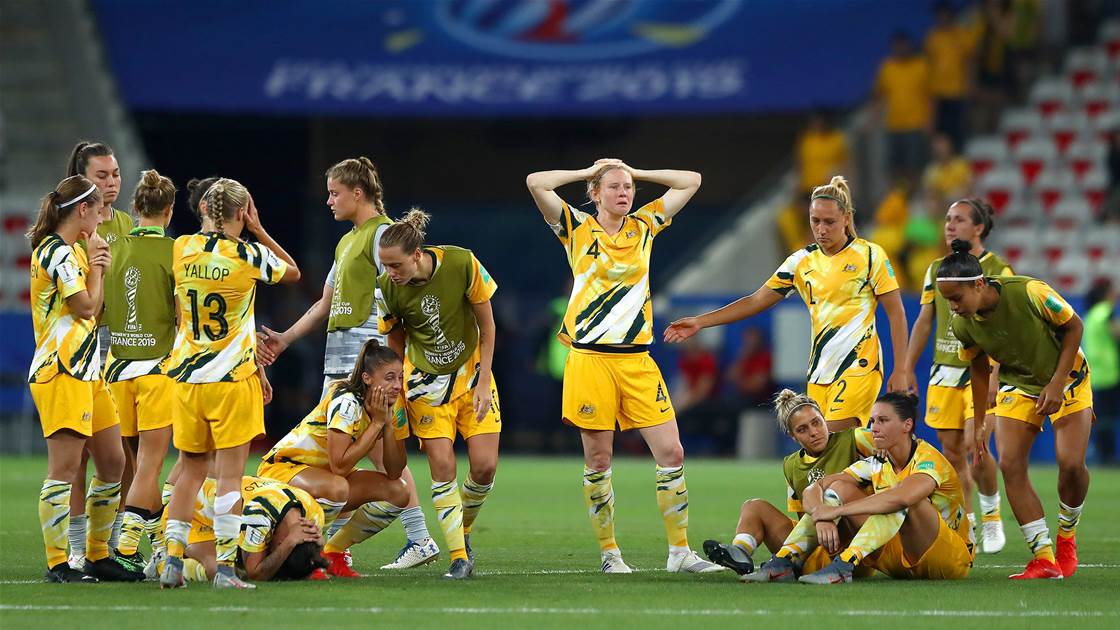First, there was the miracle in Montpellier.
Now, some are dubbing the Matildas’ penalty shootout heartbreak against Norway “the nightmare in Nice”.
For diehard Matildas fans, the scene at Stade de Nice last Saturday was one of disbelief and devastation. Those who had hoped to be booking Airbnbs in La Havre instead made their way to nearby pubs, where more than a few were in tears.
This epic knockout clash was football as long-suffering fans know it; the most dramatic of emotional rollercoasters with a touch of the VAR-cical. For some, alcohol was their only solace. Back in the SBS studios, Craig Foster had the role of providing a more composed and analytical post mortem, in which he asserted that the Matildas’ loss was a catalyst for Australia to take stock of its investment in women’s football.
“The rest of the world is accelerating,” he said on The World Game.
“The rest of the world is investing… is improving very quickly and we need to continue our improvement.
“That’s one of the big challenges to come out of this tournament, not only for FIFA [and] how much they are going to invest in the women’s game… but what about [Australia]? What are we going to do now?”
Europe catching on to women’s football — at last
The former Socceroo’s comments get to the heart of a significant challenge for Australian football moving forward — and not just because the Matildas and the Players Football Association (PFA) may be on a legal collision course with FIFA over inequitable prize money.
Equally important is the performance of European nations at this World Cup — traditionally heavyweights of the men’s game, but relative underperformers in the women’s. Over seven previous editions, only Norway (1995) and Germany (2003, 2007) have lifted the Women’s World Cup trophy, while the Grasshoppers last made quarter-finals in 2003. Critically, however, Australia’s last three international losses have been against European nations Norway, Italy and the Netherlands. When the Matildas suffered a “shock” opening loss to Italy, much was made of the improved performance of Le Azzurre, who — until 2019 — had never qualified for a Women’s World Cup.
The result, however, was not all that surprising for those who have been following the strides made for women’s football in Italy, and Europe more broadly.In April this year, 39,000 spectators sold out Juventus Stadium for the clash between the home side and Fiorentina — breaking the record for attendance at a women’s football match in Italy. Increased national interest has come on the back of the decision in 2015 to allow professional men’s clubs the option of buying a women’s licence and in 2018 the Italian Olympic Committee mandating that women’s football be managed by the professional Italian Football Federation (FIGC) rather than an amateur association. Similar advances have been made in Spain, with the Spanish football association announcing several days ago that it will invest more than 20 million euros ($32.88 million) in women’s football next year, with all top-flight matches to be screened live.
This follows 60,739 supporters showing up in March to see Barcelona defeat Atletico Madrid 2-0 in the Primera Division Femenina — in turn breaking the global attendance record for a women’s club-level football match. Perhaps the biggest game changer for women’s football, however, has occurred in England, where Sam Kerr has reportedly been offered close to $1 million to join Chelsea.
What now then for Australia and the W-League?
Europe is clearly getting serious about women’s football, with a competitive market driving ever-higher levels of investment. In this context, Kerr’s mammoth contract offer is indicative of the global risk Australia is facing should the W-League be left behind.At present, players internationally rank the Australian league as the world’s second-best behind the United States’ NWSL, where Kerr plays for Chicago. But with Europe hot on the heels, the W-League is at risk of becoming merely a “feeder” league for the world’s bigger, more lucrative competitions — unless it can generate its own competitive fight for greater investment. In a promising development, the Football Federation Australia (FFA) and PFA announced in June that W-League players will be guaranteed a like-for-like hourly rate to that of the men. Nonetheless, there are a raft of further possible improvements that could be made, albeit with a backdrop of continuing and messy governance stoushes.
For example, it is well known that the clubs would like to run the A-League, but if this were to happen, what would that mean for the W-League? What percentage investment would A-League clubs with women’s licences be committing to their women’s football operations? And could FFA counter with a more lucrative alternative, generating a better outcome for the women’s game?
These are the kinds of tricky questions that Australian football is facing moving forward. But while the answers are never easy, let the nightmare in Nice be a warning to us all: invest, or Australia’s leading role in the women’s game is almost certainly at stake.












